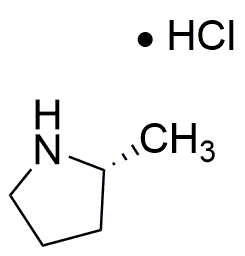(R)-2-Methylpyrrolidine hydrochloride is widely utilized in research focused on:
- Synthesis of Pharmaceuticals: This compound serves as a chiral building block in the synthesis of various pharmaceuticals, enhancing the efficacy and selectivity of drug formulations.
- Research in Neuroscience: It is used in studies related to neurotransmitter systems, providing insights into brain function and potential treatments for neurological disorders.
- Organic Chemistry Reactions: This chemical acts as a versatile reagent in organic synthesis, facilitating reactions that produce complex molecules more efficiently than traditional methods.
- Flavor and Fragrance Industry: Its unique properties make it valuable in creating specific flavors and fragrances, allowing for the development of more appealing consumer products.
- As a Solvent: It is employed as a solvent in various chemical processes, improving solubility and reaction rates, which can lead to more effective manufacturing processes.
General Information
Properties
Safety and Regulations
Applications
(R)-2-Methylpyrrolidine hydrochloride is widely utilized in research focused on:
- Synthesis of Pharmaceuticals: This compound serves as a chiral building block in the synthesis of various pharmaceuticals, enhancing the efficacy and selectivity of drug formulations.
- Research in Neuroscience: It is used in studies related to neurotransmitter systems, providing insights into brain function and potential treatments for neurological disorders.
- Organic Chemistry Reactions: This chemical acts as a versatile reagent in organic synthesis, facilitating reactions that produce complex molecules more efficiently than traditional methods.
- Flavor and Fragrance Industry: Its unique properties make it valuable in creating specific flavors and fragrances, allowing for the development of more appealing consumer products.
- As a Solvent: It is employed as a solvent in various chemical processes, improving solubility and reaction rates, which can lead to more effective manufacturing processes.
Documents
Safety Data Sheets (SDS)
The SDS provides comprehensive safety information on handling, storage, and disposal of the product.
Product Specification (PS)
The PS provides a comprehensive breakdown of the product’s properties, including chemical composition, physical state, purity, and storage requirements. It also details acceptable quality ranges and the product's intended applications.
Certificates of Analysis (COA)
Search for Certificates of Analysis (COA) by entering the products Lot Number. Lot and Batch Numbers can be found on a product’s label following the words ‘Lot’ or ‘Batch’.
*Catalog Number
*Lot Number
Certificates Of Origin (COO)
This COO confirms the country where the product was manufactured, and also details the materials and components used in it and whether it is derived from natural, synthetic, or other specific sources. This certificate may be required for customs, trade, and regulatory compliance.
*Catalog Number
*Lot Number
Safety Data Sheets (SDS)
The SDS provides comprehensive safety information on handling, storage, and disposal of the product.
DownloadProduct Specification (PS)
The PS provides a comprehensive breakdown of the product’s properties, including chemical composition, physical state, purity, and storage requirements. It also details acceptable quality ranges and the product's intended applications.
DownloadCertificates of Analysis (COA)
Search for Certificates of Analysis (COA) by entering the products Lot Number. Lot and Batch Numbers can be found on a product’s label following the words ‘Lot’ or ‘Batch’.
*Catalog Number
*Lot Number
Certificates Of Origin (COO)
This COO confirms the country where the product was manufactured, and also details the materials and components used in it and whether it is derived from natural, synthetic, or other specific sources. This certificate may be required for customs, trade, and regulatory compliance.


